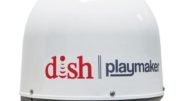This very question came through the Solid Signal support desk a couple of weeks ago. The answer is really common sense when you think about it. Bear with me, let’s take this step by step.
The reverse band
In the 2010s, DIRECTV seemed to be facing a big problem. They were expecting thousands of new 4K channels. Not only that, but their first and second generation satellite fleets were well beyond their service lives. But, you can’t just decommission one satellite and put up another one. You need months if not years of overlap. DIRECTV was running out of physical space in its satellite locations, and the cost of putting up new satellites was, no pun intended, astronomical.
So, some smart engineers came up with some smart ideas. Every satellite operates on at least two sets of frequencies. One set of frequencies is used just for signals going up, and the other is used just for signals going down. By leveraging complex physics and mind-numbingly difficult engineering theory, they came up with an idea to use the same group of frequencies to go both up AND down. The original downstream broadcast would still work, and the original upstream broadcast, referred to as “backhaul,” would also work. So, everything would be compatible with older equipment. But, there would now be a third broadcast, using the backhaul frequencies but going downstream. Since this was the reverse of how things were done before, it was called “reverse band.”
What the reverse band brings to DIRECTV
Thanks to the reverse band and the fact that there just aren’t thousands of 4K channels, the company has a huge amount of extra satellite capacity. This means better quality video through less overcompression. It also means that the company could abandon its 72.5, 95, 110, and 119 satellite locations and consolidate on three locations that nearly everyone in North America could aim towards.
DIRECTV can move programs throughout its satellite fleet with the touch of a button. It’s that easy. The reverse band has been used for less mainstream programming, like international channels. Occasionally, such as was the case in the late summer of 2022, there’s nothing at all there. But that’s expected to change as DIRECTV lights up nearly two dozen channels with NFL Sunday Ticket.
Do you need to peak your dish for the reverse band?
Well, yes and no. And that’s a good thing for DIYers. If you have a reverse-band capable dish, as practically all dishes made after 2016 are, you’ll need a fancy AIM 2.0 meter in order to properly aim it and check that everything is working right. It’s not cheap, and all things considered it will definitely be the most expensive part of your tailgate setup. If you want to do things right, you’ll need one. But chances are, you can get by without one.
Why? Here’s where the common sense comes in. DIRECTV’s reverse band broadcasts come from the same satellites as its regular broadcasts. So if you are aiming to reach the 99 degree satellite location, you’ll get the reverse band broadcasts if you simply aim for the regular ones.
A lot of pro DIRECTV installers will aim the dish for the regular broadcasts at 99, 101, and 103 and only do a quick check to make sure the reverse band broadcasts pass the built-in installation verification checks on their meters or on the receivers. Some installers, and I will do this too, will use an old-school Slimline 5 to get the fastest aim because once you peak on 101 and the still functioning 119 location you’re 99% to a perfect aim anyway. See, all the satellites are in a straight line in the sky so if you can get a great aim on 101 and 119 then 99 and 103 come along for the ride. (For the record, there’s nothing on 110 anymore.) Then you just swap in the permanent LNB and fine-tune from there. It’s actually faster that way.
Bottom line folks…
I am a big fan of the AIM meter. It makes aiming fast and practically brainless. I think you should have one. But if you can’t afford it, or consider it a luxury, don’t sweat. it. You can do without it. Then, you’ll have even more money to spend on the great stuff at SolidSignal.com.





